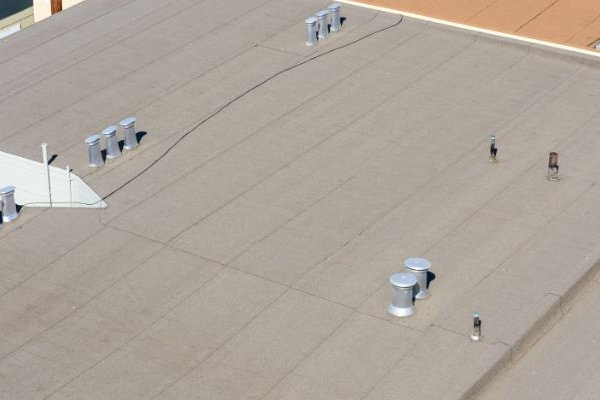4 Common Types of Commercial Flat Roofing Materials

Choosing the right material for your commercial flat roof is a critical decision. The durability and performance of the roofing material you select can dictate everything from long-term maintenance costs to the energy efficiency of your structure. Here are four common types of commercial flat roofing materials contractors and business owners choose from. By reading about them, you can determine which is the best fit for your application.
1. Single-Ply Membrane Roofing
Single-ply membrane roofing is a popular option due to its ease of installation and high reflectivity, which keeps buildings cool and lowers energy bills. This type of roofing comes in a few main varieties: PVC (polyvinyl chloride), TPO (thermoplastic polyolefin), and EPDM (ethylene propylene diene terpolymer). Each of these single-ply membranes offers a competitive edge in terms of cost and environmental benefits.
At Nasi Roofing, we specialize in Duro-Last roofing, which is a type of PVC membrane. This material offers superior resistance to weather, mold, chemical corrosion, and many other damaging factors. This makes it one of the most durable flat roofing materials on the market. Learn more about this PVC membrane option from our Duro-Last roofing contractors today.
2. Metal Roofing
Many consider metal roofing to be the pinnacle of longevity. It commonly outlasts most other roofing materials. It's highly resistant to inclement weather, fire, and pests. Metal roofing is also becoming an increasingly energy-efficient option thanks to weather sealing, reflecting sunlight and reducing cooling costs. Aesthetic qualities and potential tax credits for installing an ENERGY STAR roof add to the appeal for the eco-conscious building owner. If you’re interested in metal roofs or learning more, get in touch with Nasi Roofing. We also offer retrofit metal roofing solutions for commercial buildings.
3. Built-Up Roofing Membrane
Built-up roofing (BUR) is a traditional roofing material in the industry. Composed of layers of bitumen, reinforced fabrics, and a top layer of stone or gravel, BUR provides a thick, double barrier for protection. However, it's important to note that BUR is a heavier system that may require more significant structural support and can have a complex installation process. Also, it may not last as long as more modern flat roofing materials, as it has a shorter lifespan than most.
4. Green or Garden Roofing
For those looking to make a bold design statement and enhance the environmental impact of their building, green roofing is an innovative and eco-friendly solution. Green roofs can reduce stormwater runoff and the urban heat island effect while providing additional insulation. They require specific considerations, such as waterproofing and drainage, and are generally higher in initial cost.
Choosing the Right Material
When business owners and property managers want to choose roofing materials, they must examine several key factors. Consider the building's design, regional climate, budget, energy efficiency, and intended lifespan. It's a strategic decision requiring attention to detail and awareness of evolving technologies.
Reroofing or installing a roof on a new building is a significant investment. Each material has its own set of advantages and considerations. It's crucial to weigh the specific environmental factors, budget, and the desired longevity of the roof to select the material that best aligns with your building's needs. This is why it’s important to be aware of the common types of commercial flat roofing materials available.
However, for many flat-roofed businesses, Duro-Last membranes are an energy-efficient and durable option with many benefits. Learn more about Duro-Last materials and the installation process through Nasi Roofing today.
